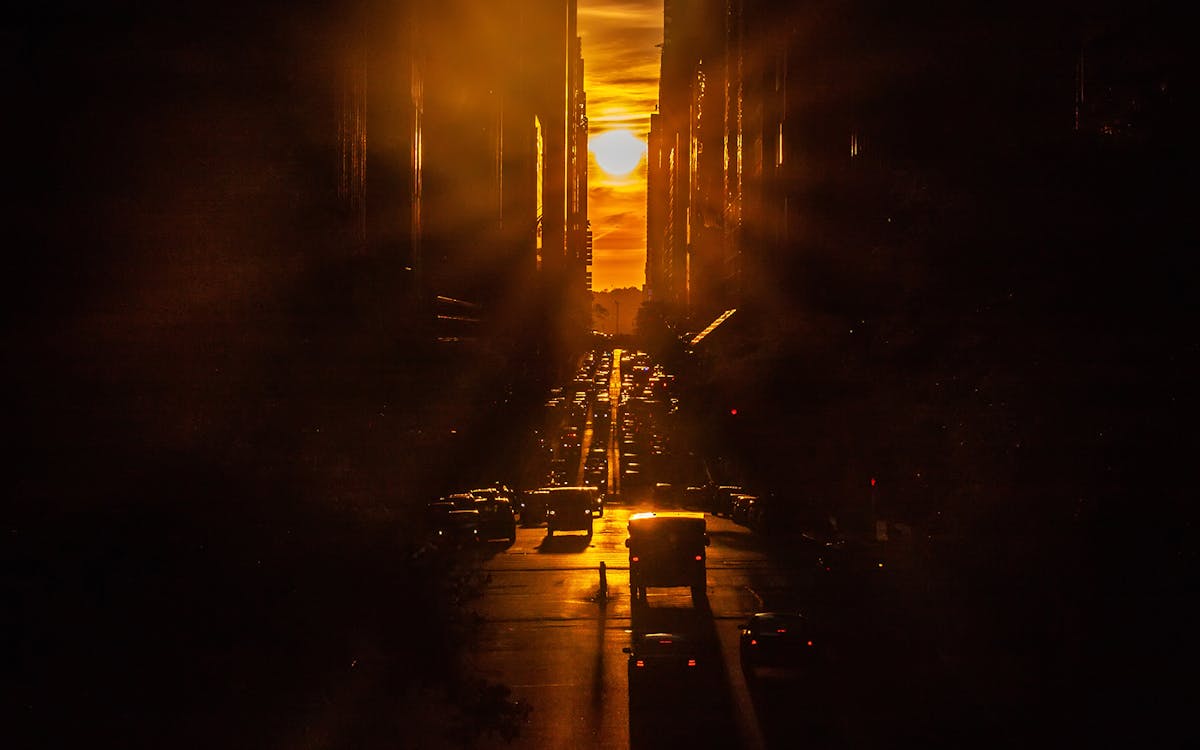In the words of Alicia Keys, this is "New York, concrete jungle where dreams are made of". But it's also where the sun and the city’s skyline come together for a breathtaking spectacle that has been renamed Manhattanhenge.

Manhattanhenge - The Scoop
Yes, indeed Manhattanhenge is a nod to the Stonehenge, a prehistoric monument in England where the sun aligns with the stones on the summer solstice. It’s just that New York astrophysicist Neil deGrasse Tyson re-coined it for New York! Manhattanhenge is a twice-yearly natural phenomenon in which the setting sun aligns perfectly with the Manhattan street grid. The Manhattanhenge sunsets occur on dates evenly spaced around the summer solstice (June 21) and winter solstice (December 21).
Reverse Manhattanhenge:
Reverse Manhattanhenge, or Winter Manhattanhenge, is a lesser-known phenomenon where the sun aligns with New York City's east-west grid during sunrises. It occurs in late November and early January. Despite being less popular due to the cold weather and early hours, it provides a unique chance to experience this alignment.
What Time is Manhattanhenge 2024?
- In 2024, the first Manhattanhenge sunset will be on Tuesday, May 28 at 8.13 PM EDT (half sun), Wednesday, May 29 at 8.12 PM EDT (full sun) and the second will be on Friday, July 12 at 8:20 PM EDT (full sun) as well as , Saturday, July 13 at 8:21 PM EDT (half sun).
- Reverse Manhattanhenge sunrises took place on January 11, 2024, at 7:11 AM EDT and with the next one expected in November, 2024.
Best Spots to Catch Manhattanhenge in NYC

The best places to catch these spectacular views are on the east-west streets that run through Midtown Manhattan, especially 14th, 23rd, 34th, 42nd, and 57th Streets. Get there about 30 minutes before sunset, when the sun is low enough in the sky to align perfectly with the streets. But to combat the crowds, go as early as three-four hours in advance.
- 14th Street and 3rd Avenue: This is one of the most popular spots to catch Manhattanhenge
- 59th Street and 5th Avenue: This is another excellent spot to catch Manhattanhenge. The sun sets directly between the Rockefeller Center and the Chrysler Building, creating a beautiful view.
- Central Park: Central Park is a great place to catch Manhattanhenge. You can find a spot on the Great Lawn or any of the other open areas in the park to enjoy the view.
Manhattanhenge - Pro Tips
- Take a really, REALLY long tripod as the crowds will ensure you don’t get the best pictures otherwise; unless you’re the height of a tall NBA player!
- Get there about 3-4 hours in advance if you want to get a proverbial front-row seat.
- When in the area, check out the Empire State Building, and Rockefeller Center with a stop at the Top of the Rock observation deck, and Radio City Music Hall.
- You could also head to the 9/11 Memorial to pay your respects to the victims of the September 11, 2001, terrorist attacks.
- Then head to Times Square for a dose of Broadway and of course, the arty folk, you don’t need us to tell you to hit up the Metropolitan Museum of Art.
This literally happens only twice a year, so you won’t want to miss out on this one!
Midtown Manhattan Attractions
As you prepare to bask in the radiant glow of the Manhattanhenge sunset, take some time out in the morning and noon to explore these captivating sights in Midtown Manhattan!
FAQs
Manhattanhenge is a natural phenomenon that occurs when the setting sun aligns perfectly with the east-west streets of Manhattan, creating a stunning visual effect.
Manhattanhenge occurs twice a year, typically around May 28th and July 12th. These dates can vary slightly depending on the position of the sun.
The term "Manhattanhenge" was coined by astrophysicist Neil deGrasse Tyson, drawing inspiration from Stonehenge, as the phenomenon resembles the alignment of the stones during solstices.
The alignment occurs due to Manhattan's street grid being oriented precisely east-west. This unique layout creates an opportunity for the sun to align perfectly with the streets during specific times of the year.
Manhattanhenge occurs four times a year, twice during the summer and twice during the winter. The summer dates are when the sun aligns with the east-west streets during sunsets, while the winter dates are for sunrises.
Yes, the dates and times of Manhattanhenge are predictable. The phenomenon occurs with a consistent pattern, allowing astronomers and enthusiasts to calculate the exact dates and times each year.
The best streets for viewing Manhattanhenge are those with a clear view of the horizon and the east-west streets, such as 14th, 23rd, 34th, 42nd, and 57th Streets.
It is recommended to arrive at least 30 minutes before the predicted time to secure a good spot for viewing. This allows you to find an ideal location and set up any photography equipment if desired.
To capture the best photographs of Manhattanhenge, it's recommended to use a tripod for stability, choose a wide-angle lens to capture the entire scene, and adjust the exposure settings to balance the brightness of the sun and the cityscape.
While Manhattan offers the best view of Manhattanhenge due to its east-west street grid, the phenomenon can also be seen from other locations in New York City, especially those with a clear view of the horizon and the city's streets.


